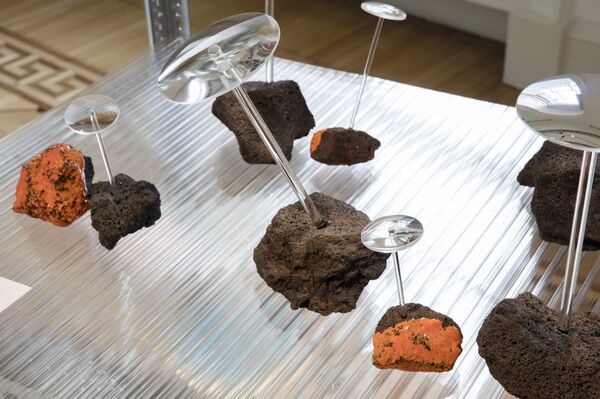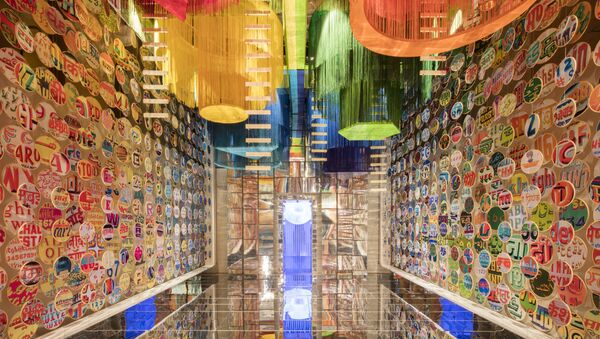The three week take-over at Somerset House in Central London will take visitors on an 'around-the-world' journey through both contemporary and historical design expressions, with an entertaining and inspiring exploration of the role design plays in all of our collective futures worldwide.

Speaking about the process of organizing such a diversely represented event, Director of London's first Design Biennale in UK, Dr. Christopher Turner said:
"The response has been extraordinary and we are delighted to have such a richly varied array of projects to present. The 37 installations promise to provide an inspiring and energizing tour of the world through design, which will entertain our visitors, provoke debate and foster collaboration."
Underlying much of the themes around "Utopia" are a number of pressing, universal issues that designers from both the past and present around the world have been seeking to address, among them sustainability, migration, pollution, political unrest, water and social equality.
Some of the vast array of thought-provoking designs include Mexico's work entitled "Binational City" which presents a fictional vision for the borders of US and Mexico.
Indonesia's work entitled "Dreaming a Billion dreams" is said to be inspired by the principles of promoting peace and cooperation in the world.

Ecotopia is a design project showcased by Dr. Alan Marshall, a Thailand based lecturer in Environmental Science, who takes the audience on a whirlwind journey through space and time, across the globe and into the future to 100 geographically real cities around the globe; all of which he envisions as becoming super ecofriendly in a distant future world.
@AG_Mitchual My utopia: sleeping to soft music somewhere like this pic.twitter.com/OBpF5vn7zr
— AlanMarshall (@DrAlanMarshall) August 19, 2016
Visitors can also enjoy various experiential aspects of the festival calendar by indulging in a pomegranate juice, falafel or a wet shave in what is described as a recreation of a bustling Beirut street on the Thames riverfront. They can also eat food in a tranquil forest-like setting as well as relax in the mouths of ferocious beasts, or even wander around virtual reality realisations of smart city's of the future.

Sir John Sorrell is president of London's Design Biennale and speaking about the event he said: "The London Design Biennale celebrates design as an international language, which everyone can understand. It does not recognise boundaries or borders. It is always seeking to make the world a better place. All over the world, nations and cities are increasingly recognising the power of design to bring social change and economic growth. They are realising that creativity, with design at its heart, can play a vital role in providing solutions to problems which affect the way people live."
Sputnik spoke to Alexandra Sankova from Moscow Design Museum, who discussed the historical influence of Russia's installation spanning pre-revolutionary to Soviet periods, and all the way through to contemporary Russian design trends.
"We wanted to promote the history of Russian design as after the collapse of the Soviet Union, so many archives and design projects were lost and even thrown away. In Russia, even the word 'design' wasn't recognized until 1989, prior to which individuals were simply known as "constructers," architects or artists and so, there is now a real interest in how global design industries impact all of our lives," Ms. Sankova told Sputnik.
With @MosDesignMuseum's Alexandra Sankova and "Lost Archives of Soviet Design" https://t.co/DFhN541zJk #LDB2016 pic.twitter.com/Uf7xiY8StA
— Caroline Baumann (@baumtweet) September 6, 2016
Speaking about some of the curated works commissioned by the Moscow based museum of Design, Alexandra Sankova added:
"Many designers in the past who were based in Russia created visions for future housing, much of which accurately show living trends today. Even artistic replications of gadgets that are prevalent worldwide today such as iPads and iPods as well as new types of transportation vehicles were depicted by Russian designers decades before they have been created."

With design works from so many countries being represented over the 3 week-long festival, the concept of connecting people regardless of geopolitical, cultural and artistic differences is something that both the organizers and the country representatives showcasing their work hope will resonate with visitors.
Alexandra Sankova from Moscow Design Museum elaborated a little further on the universal aspects of the festival:
"Design, regardless of where it originates should be helpful for humanity. It should be about life, about sharing information and encouraging collaboration as opposed to division. Design and art must cross beyond any perceived differences and encourage humans everywhere to get closer," she explained.

Some of the many other countries showcasing innovative and vibrant expressions of design include Israel, India, South Africa, France, Austria, UK and many more.
Further info on key dates over the coming three weeks can be found via the festival website.




